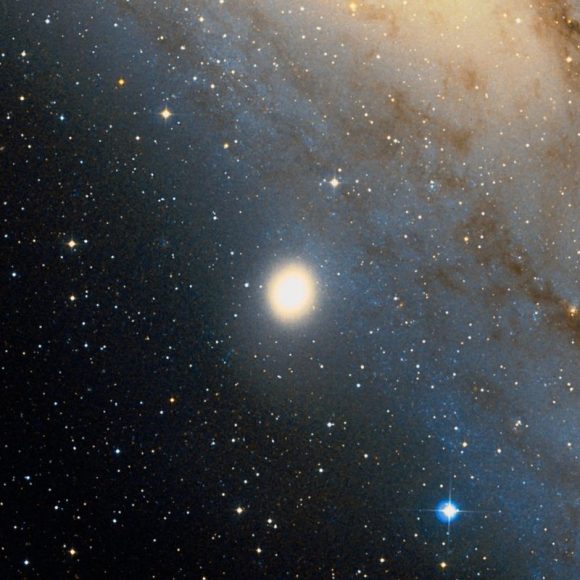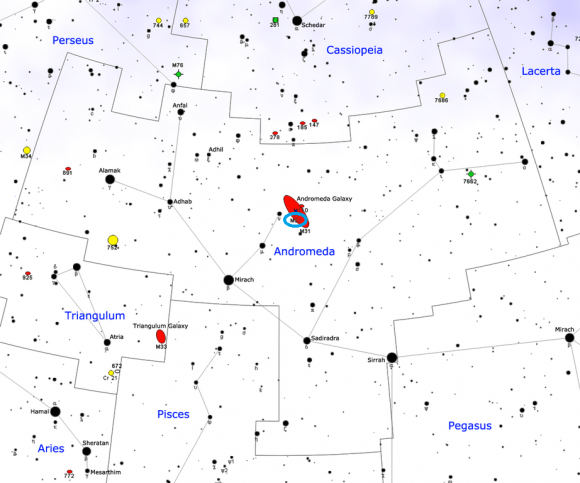Welcome back to Messier Monday! In our ongoing tribute to the great Tammy Plotner, we take a look at dwarf elliptical galaxy known as Messier 32. Enjoy!
During the 18th century, famed French astronomer Charles Messier noted the presence of several “nebulous objects” in the night sky. Having originally mistaken them for comets, he began compiling a list of them so that others would not make the same mistake he did. In time, this list (known as the Messier Catalog) would come to include 100 of the most fabulous objects in the night sky.
One of these objects is the dwarf elliptical galaxy known as Messier 32 (aka. NGC 221). Located about 2.65 million light-years from Earth, in the direction of the Andromeda constellation, this dwarf is actually a satellite galaxy of the massive Andromeda Galaxy (M31). Along with Andromeda, the Milky Way and the Triangulum Galaxy (M33) is a member of the Local Group.
Description:
M32 is an elliptical dwarf galaxy which contains about 3 billion solar masses. While it looks small compared to its massive neighbor, this little guy actually stretches across space some 8,000 light years in diameter. Once you pick it up, you’ll notice it’s really quite bright on its own – and with very good reason – its nucleus is almost identical to M31. Both contain about 100 million solar masses in rapid motion around a central supermassive object!

As Alister W. Graham wrote in his 2002 study – titled “Evidence for an outer disk in the Prototype `Compact Elliptical’ Galaxy M32“:
“M32 is the prototype for the relatively rare class of galaxies referred to as compact ellipticals. It has been suggested that M32 may be a tidally disturbed r1/4 elliptical galaxy or the remnant bulge of a disk-stripped early-type spiral galaxy reveals that the surface bightness profile, the velocity dispersion measurements, and the estimated supermassive black hole mass in M32 are inconsistent with the galaxy having, and probably ever having had, an r1/4 light profile. Instead, the radial surface brightness distribution of M32 resembles an almost perfect (bulge+exponential disk) profile; this is accompanied by a marked increase in the ellipticity profile and an associated change in the position angle profile where the “disk” starts to dominate. Compelling evidence that this bulge/disk interpretation is accurate comes from the best-fitting r1/n bulge model, which has a Sersic index of n=1.5, in agreement with the recently discovered relation between a bulge’s Sersic index and the mass of a bulge’s supermassive black hole.”
By probing deeply into Messier 32, we’ve learned this little galaxy is home to mainly mature red and yellow stars. And they’re good housekeepers, too… because there’s practically no dust or gas to be found. While this seems neat and tidy, it also means there isn’t any new star formation going on either, but there are signs of some lively doings in the not too distant past.
Because M32 has shared “space” with neighboring massive M31, the strong tidal field of the larger galaxy may have ripped away what once could have been spiral arms – leaving only its central bulge and triggering starburst in the core. As Kenji Bekki (et al) wrote in their 2001 study:
“The origin of M32, the closest compact elliptical galaxy (cE), is a long-standing puzzle of galaxy formation in the Local Group. Our N-body/smoothed particle hydrodynamics simulations suggest a new scenario in which the strong tidal field of M31 can transform a spiral galaxy into a compact elliptical galaxy. As a low-luminosity spiral galaxy plunges into the central region of M31, most of the outer stellar and gaseous components of its disk are dramatically stripped as a result of M31’s tidal field. The central bulge component on the other hand, is just weakly influenced by the tidal field, owing to its compact configuration, and retains its morphology. M31’s strong tidal field also induces rapid gas transfer to the central region, triggers a nuclear starburst, and consequently forms the central high-density and more metal-rich stellar populations with relatively young ages. Thus, in this scenario, M32 was previously the bulge of a spiral galaxy tidally interacting with M31 several gigayears ago. Furthermore, we suggest that cE’s like M32 are rare, the result of both the rather narrow parameter space for tidal interactions that morphologically transform spiral galaxies into cE’s and the very short timescale (less than a few times 109 yr) for cE’s to be swallowed by their giant host galaxies (via dynamical friction) after their formation.”

History of Observation:
M32 was discovered by Guillaume Le Gentil on October 29th, 1749 and became the first elliptical galaxy ever observed. Although it wasn’t cataloged by Charles Messier until August 3rd, 1764, he had also seen it some seven years earlier while studying at the Paris Observatory, but his notes had been suppressed. But no matter, for he made sure to include it in his notes with a drawing! As he wrote of the object:
“I have examined in the same night [August 3 to 4, 1764], and with the same instruments, the small nebula which is below and at some [arc] minutes from that in the girdle of Andromeda. M. le Gentil discovered it on October 29, 1749. I saw it for the first time in 1757. When I examined the former, I did not know previously of the discovery which had been made by M. Le Gentil, although he had published it in the second volume of the Memoires de Savans erangers, page 137. Here is what I found written in my journal of 1764. That small nebula is round and may have a diameter of 2 minutes of arc: between that small nebula and that in the girdle of Andromeda one sees two small telescopic stars. In 1757, I made a drawing of that nebula, together with the old one, and I have not found and change at each time I have reviewed it: One sees with difficulty that nebula with an ordinary refractor of three feet and a half; its light is fainter than that of the old one, and it doesn’t contain any star. At the passage of that new nebula through the Meridian, comparing it with the star Gamma Andromedae, I have determined its position in right ascension as 7d 27′ 32″, and its declination as 38d 45′ 34″ north.”
Later, Messier 32 would be examined again, this time by Admiral Symth who said:
“An overpowering nebula, with a companion about 25′ in the south vertical M32 … The companion of M31 was discovered in November, 1749, by Le Gentil, and was described by him as being about an eighth of the size of the principal one. The light is certainly more feeble than here assigned. Messier – whose No. 32 it is – observed it closely in 1764, and remarked, that no change had taken place since the time of its being first recorded. In form it is nearly circular. The powerful telescope of Lord Rosse is a reflector of three feet in diameter, of performance hitherto unequalled. It was executed by the Earl of Rosse, under a rare union of skill, assiduity, perseverance, and muniference. The years of application required to accomplish this, have not worn his Lordship’s zeal and spirit; like a giant refreshed, he has returned to his task, and is now occupied upon a metallic disc of no less than six feet in diameter. Should the figure of this prove as perfect as the present one, we may soon over-lap what many absurdly look upon as the boundaries of the creation.”

Locating Messier 32:
Locating M32 is as easy as locating the Andromeda Galaxy, but it will require large binoculars or at least a small telescope to see. Even under moderately light polluted skies the Great Andromeda Galaxy can be easily be found with the unaided eye – if you know where to look. Seasoned amateur astronomers can literally point to the sky and show you the location of M31, but perhaps you have never tried to find it.
Believe it or not, this is an easy galaxy to spot even under the moonlight. Simply identify the large diamond-shaped pattern of stars that is the Great Square of Pegasus. The northernmost star is Alpha, and it is here we will begin our hop. Stay with the northern chain of stars and look four finger widths away from Alpha for an easily seen star.
The next along the chain is about three more finger widths away… And we’re almost there. Two more finger widths to the north and you will see a dimmer star that looks like it has something smudgy nearby. Point your binoculars there, because that’s no cloud – it’s the Andromeda Galaxy!
Now aim your binoculars or telescope its way… Perhaps one of the most outstanding of all galaxies to the novice observer, M31 spans so much sky that it takes up several fields of view in a larger telescope, and even contains its own clusters and nebulae with New General Catalog designations. If you have larger binoculars or a telescope, you will be able to pick up M31’s two companions – M32 and M110. Messier 32 is the elliptical galaxy to the south.
Why not stretch your own boundaries? Go observing! Halton Arp included Messier 32 as No. 168 in his Catalogue of Peculiar Galaxies. It’s bright, easy and fun! And here are the quick facts on this Messier Object to help you get started:
Object Name: Messier 32
Alternative Designations: M32, NGC 221
Object Type: Type E2, Elliptical Galaxy
Constellation: Andromeda
Right Ascension: 00 : 42.7 (h:m)
Declination: +40 : 52 (deg:m)
Distance: 2900 (kly)
Visual Brightness: 8.1 (mag)
Apparent Dimension: 8×6 (arc min)
We have written many interesting articles about Messier Objects here at Universe Today. Here’s Tammy Plotner’s Introduction to the Messier Objects, , M1 – The Crab Nebula, M8 – The Lagoon Nebula, and David Dickison’s articles on the 2013 and 2014 Messier Marathons.
Be to sure to check out our complete Messier Catalog. And for more information, check out the SEDS Messier Database.
Sources:

